

World has no capacity to absorb new fossil fuel plants, warns IEA. The world has so many existing fossil fuel projects that it cannot afford to build any more polluting infrastructure without busting international climate change goals, the global energy watchdog has warned.
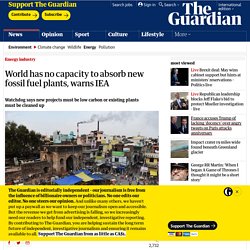
The International Energy Agency said almost all of the world’s carbon budget up to 2040 – the amount that can be emitted without causing dangerous warming – would be eaten up by today’s power stations, vehicles and industrial facilities. Fatih Birol, the executive director of the Paris-based group, told the Guardian: “We have no room to build anything that emits CO2 emissions.” The economist said to limit temperature rises to 2C, let alone the 1.5C as scientists recommend, either all new energy projects would have to be low carbon, which was unlikely, or existing infrastructure would need to be cleaned up.
Britain's energy supply is in jeopardy after Brexit, warn MPs. The future of Britain’s power supply has been jeopardised by Brexit and the government must act urgently to ensure nuclear power stations stay open, MPs have warned.
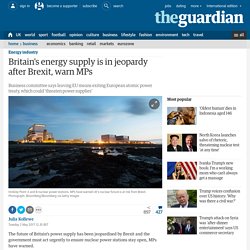
The influential business, energy and industrial strategy committee said that any gap between the UK leaving a European atomic power treaty and entering into secure alternative deals would “severely inhibit nuclear trade and research and threaten power supplies”. The cross-party group of MPs said it shared the nuclear industry’s concern that it would take more than two years to hammer out a new deal for regulating nuclear power stations and trade. It urged the government to delay exit from the European Atomic Energy Community (Euratom) or set up transitional arrangements, which may need to be longer than the three years proposed by the European parliament.
In a stark warning, Iain Wright, the committee’s chair, said: “The impact of Brexit on Euratom has not been thought through. New super batteries could charge phones in seconds and electric cars in minutes. A scientific breakthrough at the University of Surrey could completely change how we charge our devices.
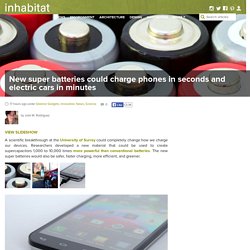
Researchers developed a new material that could be used to create supercapacitors 1,000 to 10,000 times more powerful than conventional batteries. The new super batteries would also be safer, faster charging, more efficient, and greener. The breakthrough is made possible by a special type of polymer that is, surprisingly enough, adapted from the principles used to make soft contact lenses. Supercapacitors have long been considered a superior alternative to batteries – able to charge and discharge energy incredibly quickly. However, until now, the materials used for these devices have had a poor energy density that limited their usefulness. How a US energy company tried to sell its failing ‘clean coal’ project to the world. The company behind America’s flagship ‘clean coal’ project tried to push the technology on countries around the world, even after they discovered its profound problems, Energydesk can reveal.

Last month a New York Times investigation chronicled the spiralling costs, missed deadlines, technical issues and administrative chaos at Southern Company’s coal gasification facility in Mississippi. The Kemper project, as it is called, is currently more than $4 billion over budget and more than two years late, with Southern now promising it will begin delivering ‘clean coal’ power no later than September 30th.
Impurities are going down and fusion yield is going up at LPP Fusion. LPP Fusion uses pulsed fusion shots.

The eventual plan is to be able to generate commercial energy using dense plasma focused fusion. Currently shots (test firings) are cleaning remaining impurities from the machine and it may take quite a few more, 100-200, to get to the purity level they need. They think if we get to that purity level and get 10 Joules of fusion output, they’ll have the results they need to get the investments they need for future work.
Roughly, it will take about $150,000 to fire 200 shots. They have raised the funds for 20 of the shots and performed those tests. Go here to donate to LPP Fusion. If successful with their research and then commercialization they will achieve commercial nuclear fusion at the cost of $400,000-1 million for a 5 megawatt generator that would produce power for about 0.3 cents per kwh instead of 6 cents per kwh for coal and natural gas. UC Irvine invents nanowire battery material with off-the-charts charging capacity. University of California, Irvine researchers have invented nanowire-based battery material that can be recharged hundreds of thousands of times, moving us closer to a battery that would never require replacement.

The breakthrough work could lead to commercial batteries with greatly lengthened lifespans for computers, smartphones, appliances, cars and spacecraft. Scientists have long sought to use nanowires in batteries. Thousands of times thinner than a human hair, they’re highly conductive and feature a large surface area for the storage and transfer of electrons. Wind and Solar Are Crushing Fossil Fuels. Wind and solar have grown seemingly unstoppable.
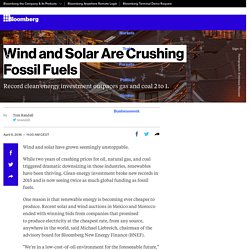
While two years of crashing prices for oil, natural gas, and coal triggered dramatic downsizing in those industries, renewables have been thriving. Clean energy investment broke new records in 2015 and is now seeing twice as much global funding as fossil fuels. One reason is that renewable energy is becoming ever cheaper to produce. Recent solar and wind auctions in Mexico and Morocco ended with winning bids from companies that promised to produce electricity at the cheapest rate, from any source, anywhere in the world, said Michael Liebreich, chairman of the advisory board for Bloomberg New Energy Finance (BNEF).
EDF extends life of four nuclear reactors. EDF plans to extend the life of four nuclear power plants in the UK and said that it was close to announcing a decision on its investment in two new reactors at Hinkley Point.
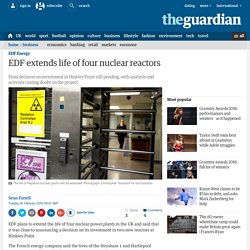
The French energy company said the lives of the Heysham 1 and Hartlepool plants would be extended by five years until 2024 and the closure dates of Heysham 2 and Torness will be delayed by seven years to 2030. Why 2015 may be remembered as a transformative year for how we get energy. Construction takes place at Roha Dyechem solar plant at Bhadla, north of Jodhpur in the western Indian state of Rajasthan.
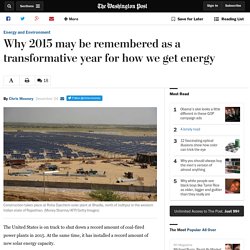
(Money Sharma/AFP/Getty Images) The United States is on track to shut down a record amount of coal-fired power plants in 2015. At the same time, it has installed a record amount of new solar energy capacity. The past year, in other words, hints at a historic transition for the U.S. energy sector. Bill Gates and Mark Zuckerberg join tech titans to launch the Breakthrough Energy Coalition.
The founders of Facebook and Microsoft are joining forces with a worldwide group of tech titans to launch the Breakthrough Energy Coalition, a massive investment fund dedicated to clean energy.
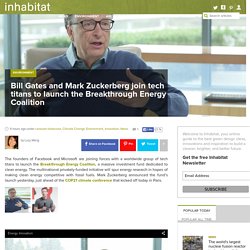
The multinational privately-funded initiative will spur energy research in hopes of making clean energy competitive with fossil fuels. Mark Zuckerberg announced the fund’s launch yesterday, just ahead of the COP21 climate conference that kicked off today in Paris. Clean energy in refugee camps could save millions of dollars. Stretched humanitarian agencies could save millions of dollars – and reduce carbon emissions, deforestation and violence against women and girls – if solar power and other clean energy sources were installed at refugee camps, according to new analysis released today. In the first report looking into energy use in refugee camps around the world, a consortium of NGOs, thinktanks and donors says that the refugees’ energy use has been neglected by both the international energy access lobby and by humanitarian agencies. In refugee camps, 90% of families have no access to electricity.
There’s also often no street lighting, putting women and girls at greater risk of sexual attack if they need to go to the toilet at night. “This as an energy access problem,” said one of the report’s authors, Chatham House senior research fellow Glada Lahn , at the launch of the report last week. The report’s authors recommend humanitarian agencies move away from a donations-focused funding model.
UK’s high-wire act on power supplies laid bare. Is America completely unprepared for a power grid cyberattack? GWEN IFILL: Now: another addition to the NewsHour bookshelf. It’s a warning about the vulnerability of the country’s power grid. And it comes from Ted Koppel, the veteran newsman and former anchor of ABC’s Nightline. I talked with him recently about his new book, “Lights Out: A Cyberattack, A Nation Unprepared, Surviving the Aftermath.”
Ted Koppel, welcome. Forbes Welcome. These Three Trends Have Radically Redefined the Energy Market. Michael Liebreich, the founder of Bloomberg New Energy Finance, set out the trends upending the global energy markets and ushering in what he termed an “age of plenty.” He said: 1. Cheap fossil fuels are here to stay because production costs are tumbling. 2. Intermittent renewables will dominate electricity supply by 2040, with huge challenges for grid managers. ISIS is attacking the U.S. energy grid - Oct. 15, 2015. U.S. law enforcement officials revealed the hack attempts on Wednesday at a conference of American energy firms who were meeting about national security concerns. "ISIL is beginning to perpetrate cyberattacks," Caitlin Durkovich, assistant secretary for infrastructure protection at the Department of Homeland Security, told company executives.
Investigators would not reveal any details to CNNMoney -- or cite evidence of specific incidents. But they did say the attacks by the Islamic State have been unsuccessful. Terrorists are not currently using the most sophisticated hacking tools to break into computer systems and turn off or blow up machines. "Strong intent. Windfarm commissioner appointed with strong credentials in renewables. The Turnbull government has appointed an academic and company director with strong ties to climate and renewables research as its new “wind commissioner”, in a move the clean energy industry says should help return the wind energy debate to “sensible”. Andrew Dyer serves on the boards of Climateworks Australia and the Monash University sustainability unit.
Renewable Energy Financing Hits a Snag. Leading solar entrepreneur to put business into liquidation. One of Britain’s leading solar entrepreneurs is set to announce that his business has gone into liquidation, in the third high-profile casualty for the sector this month.
Oil and Gas. Stranded Assets. Future of Energy. Innovative solutions required to meet Africa’s rising electricity demand — FT. U.S.-Canada electricity trade increases. July 9, 2015 Source: U.S. Energy Information Administration, based on National Energy Board of CanadaNote: A small amount of electricity is traded by states outside the regions shown.
Republished July 9, 2015, 3:30 p.m. to clarify the text. U.S. electricity trade with Canada is increasing, providing more economic and reliability benefits to both the United States and Canada. India’s per capita electricity consumption touches 1010 kWh. New Delhi: In an indication of growing appetite for electricity in India, the country’s per capita electricity consumption has reached 1010 kilowatt-hour (kWh) in 2014-15, compared with 957 kWh in 2013-14 and 914.41 kWh in 2012-13, according to the Central Electricity Authority (CEA), India’s apex power sector planning body. “The per capita electricity consumption reached 1010 kWh some time back,” said a senior government official, requesting anonymity.
Electricity network in 'uncharted territory' as blackouts loom. His concerns were brought into sharper focus last week with the announcement that the Eggborough power station in Yorkshire would close in March 2016. The plant generates around 4pc of the UK’s electricity and its shutdown at the end of the winter will place a further squeeze on the safety cushion for avoiding a blackout across large areas of the country. Conventional fossil-fuel burning power stations like Eggborough and the Longannet coal-fired plant in Fife that is also due to close in March are still the most reliable means to produce electricity for the grid, despite the dramatic shift over the last decade towards renewables such as wind or solar. California Approves Distributed Energy Resource Providers To Aggregate Renewable Energy Generation - Renewable Energy World.
The Future of Renewable Power in Mexico - Renewable Energy World. Renewable Energy Gains Greater Opportunity in US Clean Power Plan - Renewable Energy World. After a year of being pummeled by opponents, Obama’s final carbon reduction plan emerged this week with an even stronger push for renewable energy. Wind and solar energy are centerpieces of the Clean Power Plan, the United States’ first ever rule to reduce carbon dioxide from power plants. The rule not only makes renewables one of the plan’s three central building blocks, but also creates special incentives to spur communities to build renewables more quickly than required.
The revised version of the rule comes after a year of review, hundreds of meetings and 4.3 million public comments delivered to EPA. It requires that states come up with plans to cut carbon pollution from power plants by 870 million tons, or 32 percent below 2005 levels, in 2030. Starbucks, Wal-Mart, Nike, Goldman Sachs take on 100% renewable energy pledge. One million households ditch the Big Six energy suppliers. However, the vast majority of UK households are still languishing on the expensive standard tariffs of one of the Big Six suppliers - British Gas, SSE, EDF Energy, E.On, ScottishPower and npower. What Clean-Energy Innovators Can Learn from Apple. UK guarantees £2bn nuclear plant deal as China investment announced. Emerging Energy Trends In Africa. This Week In Energy: A Dangerous Global Trend Emerging. Power Shifts: Emerging clean energy markets.
Emerging trends in energy management. Tesla Is Betting on Solar, Not Just Batteries. FT. Shale glut turbocharges motoring revival — FT. FT. Supramolecular nanofibers could create super efficient solar energy. UK faces second winter with dearth of spare power capacity. This wind turbine has no blades — and that’s why it’s better. Ricoh invents super-efficient power-producing rubber. Germany more than doubled its wind power capacity in 2014. The Logic of Divestment: Why We Have to Kiss Off Big Carbon. The rise and fall of nuclear power, in 6 charts. A Pipeline and a Pie in the Sky. UK using less energy despite growing economy, report finds. How Solar Power Could Slay the Fossil Fuel Empire by 2030.
Cool things that multi-task better than you and I: an electric road in South Korea. Mr. Fusion? Compact Fusion Reactor Will be Available in 5 Years Says Lockheed-Martin. Tech News, Gaming, Social Networking - HuffPost Tech UK. Wind power is cheapest energy, EU analysis finds. New Li-Ion Batteries Charge 70 Percent in 2 Minutes, Last for 20 Years. New Solar Cells Use Perovskite to Turn Water into Energy. Faster, Better Hydrogen Production. Soon Europe Might Not Need Power Plants – A New Energy Revolution Is Coming. Oil industry on borrowed time as switch to gas and solar accelerates. Spray-painted solar cells promise cheap power on seemingly any surface. New Propulsion System could Revolutionize Space Travel. Good news for electric cars: New battery tech uses peroxide to boost energy density by 7X.
Five Shocking Places Where Fracking Is Taking Off. Another Panic Sell Downgrade in Coal - James River Coal Company (NASDAQ:JRCC) About The Great Energy Challenge. Freshwater 101: Energy and Industry. Solar energy prospects are bright for Scotland, experts say. The Red Hot Renewable That Could Incite A Green Power Revolution. Daniel Yergin on the next energy revolution. New Solar Farm Produces Enough Electricity for 140,000 Homes. These Solar Roads Could Power The Entire Country. "Green" Jet Fuel From Sunlight Developed. Saliva as Fuel? It's Not Just Science Fiction. Thirsty energy: the conflict between demands for power and water. Top 7 Reasons To Go For An Electric Vehicle. Western Australia wave energy project on the brink of commercialisation. Unrestrained Oil and Gas Is the Future, ExxonMobil Argues. Inhabitat. Cheap batteries will revolutionise the renewable energy market.
Does Himalayan Hydro have the Power to Bring Water Co-operation? 2014 World Cup to nearly double carbon emissions over 2010. African Countries Win $330M For Climate Investment. Blowing Up The Off-Grid Solar & Cleantech Market. ‘Watershed’ Climate and Energy Agreement Between CenterPoint Energy and City of Minneapolis. Australia's Solar Systems Are More Efficient Now. Goodbye Megatons to Megawatts. Hello, Energy Efficiency. The Rodin Coil: The Greatest Discovery of All Time? Energy bills predicted to rise by £700 over 17 years. Bills rise for 8m British Gas customers. RWE scraps British wind farm amid political energy row. UK energy firm stokes growing political row with price hike.
Boardroom coup shakes UK shale player Dart Energy. Energy bills rise by 37% in three years. Electricity supply and demand balance: a satisfactory winter 2013-2014 but growing concern from 2016 onwards. Toyota fuel cell car set for 2015 global release.